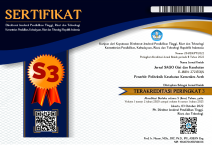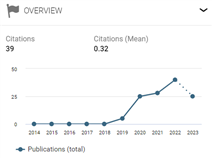Hubungan asupan zat gizi makro dan aktivitas fisik terhadap status gizi mahasiswa Universitas Sriwijaya: Studi cross-sectional
DOI: 10.30867/gikes.v6i2.2272Abstract
Background: One of the fundamental aspects of nutritional problems arises due to the imbalance of food intake and body needs, which can lead to over or undernutrition. Research shows that 20,45% of university students are underweight and 4,54% are obese. College students are prone to disordered eating patterns, fast food consumption, and lack of physical activity, which can affect health and academic performance.
Objective: To analyze the relationship between lunch macronutrient intake, physical activity, and nutritional status in Sriwijaya University students.
Methods: This cross-sectional study involved 102 active students (2019–2023) who ate lunch at the faculty canteen, selected using purposive sampling considering class proportion. 24-hour food recall (two non-consecutive days) assessed nutrient intake, Body Mass Index (BMI) determined nutritional status, and the IPAQ questionnaire measured physical activity.
Results: Significant relationships were found between energy intake (p = 0,000), carbohydrate intake (p = 0,000), protein intake (p = 0,001), fat intake (p = 0,006), and physical activity (p = 0,008) with nutritional status. Students with imbalanced nutrient intake and low physical activity were at higher risk of abnormal nutritional status.
Conclusion: The study concludes that there is a significant relationship between lunchtime energy intake, carbohydrate intake, protein intake, fat intake, and physical activity with the nutritional status of Universitas Sriwijaya students. Students should maintain a balanced diet and increase physical activity to achieve optimal nutrition.
Keywords
Full Text:
PDFReferences
Abduh, M., Alawiyah, T., Apriansyah, G., Sirodj, R. A., & Afgani, M. W. (2023). Survey Design: cross sectional dalam penelitian kualitatif. Jurnal Pendidikan Sains Dan Komputer, 3(1), 31–39. https://doi.org/10.22437/jiituj.v5i1.12886
Afriansyah, E., Yuswita, E., & Fitriyani, L. (2023). Hubungan tingkat kecukupan asupan gizi (karbohidrat, protein, lemak dan zat besi) sebagai faktor resiko kejadian stunting pada balita < 5 tahun di Kota Depok Tahun 2023. Jurnal Kesehatan Tambusai, 4(4), 6427–6433. https://doi.org/10.31004/jkt.v4i4.21448
Akbar, F., Hamsah, I. A., & Muspiati, A. (2020). Gambaran nutrisi lansia di Desa Banua Baru. Jurnal Ilmiah Kesehatan Sandi Husada, 11(1), 1–7. https://doi.org/10.35816/jiskh.v10i2.193
Alkazemi, D. (2019). Gender differences in weight status, dietary habits, and health attitudes among college students in Kuwait: A cross-sectional study. Nutrition and Health, 25(2), 75–84. https://doi.org/10.1177/0260106018817410
Azis, N., Wahidin, A. J., Cakranegara, P. A., Muditomo, A., & Efendi, E. (2022). Visualization of tourist visit time series data using google data studio. Jurnal Mantik, 6(2), 2153–2159. https://doi.org/10.35335/mantik.v6i2.2731
BKPK Kemenkes. (2023). Laporan Survei Kesehatan Indonesia 2023 Dalam Angka.
Carreiro, A. L., Dhillon, J., Gordon, S., Higgins, K., Jacobs, A., McArthur, B. M., Redan, B. W., Rivera, R., Schmidt, L. R., & Mattes, R. D. (2016). The macronutrients, appetite, and energy intake. Annual Review of Nutrition. https://doi.org/10.1146/annurev-nutr-121415-112624
Corrêa Leite, M. L. (2021). Log-Ratio transformations for dietary compositions: numerical and conceptual questions. Journal of Nutritional Science. https://doi.org/10.1017/jns.2021.93
Craig, C. L., Marshall, A. L., Sjöström, M., Bauman, A. E., Booth, M. L., Ainsworth, B. E., Pratt, M., Ekelund, U., Yngve, A., Sallis, J. F., & Oja, P. (2003). International physical activity questionnaire: 12-country reliability and validity. Medicine & Science in Sports & Exercise, 35(8), 1381–1395. https://doi.org/10.1249/01.MSS.0000078924.61453.FB
Deliens, T., Deforche, B., De Bourdeaudhuij, I., & Clarys, P. (2015). Determinants of physical activity and sedentary behaviour in university students: A qualitative study using focus group discussions. BMC Public Health, 15(1), 1–9. https://doi.org/10.1186/s12889-015-1553-4
Dhanny, D. R., & Sefriantina, S. (2022). Hubungan asupan energi, asupan protein dan status gizi terhadap kejadian tuberkulosis pada anak. Muhammadiyah Journal of Nutrition and Food Science (MJNF), 2(2), 58–68. https://doi.org/10.24853/mjnf.2.2.58-68
Ermona, N. D. N., & Wirjatmadi, B. (2018). Relationship between physical activity, nutrition intake and overweight status among elementary school student in SDN Ketabang 1 Surabaya 2017. Amerta Nutrition, 2(1), 97–105. https://doi.org/10.20473/amnt.v2i1.2018.97-105
Fadilah, N., & Sefrina, L. R. (2022). Hubungan pola makan, asupan kebisaan makan, dan aktifitas fisik terhadap kejadian obesitas pada anak sekolah dasar : literature review. Jumantik (Jurnal Ilmiah Penelitian Kesehatan), 7(3), 200–210. https://doi.org/10.30829/jumantik.v7i3.11500
Hasanah S, N., Suhadi, S., & Harleli, H. (2024). Hubungan pengetahuan gizi, jumlah uang saku dan kebiasaan konsumsi fast food dengan status gizi pada mahasiswa fakultas ekonomi dan bisnis Universitas Halu Oleo Tahun 2023. Jgki. https://doi.org/10.37887/jgki.v4i4.47116
Hidayah, N., Maimunah, S., & Ramdhani, N. W. (2023). Status gizi berhubungan dengan konsumsi makanan cepat saji aktivitas fisik dan kualitas tidur. Malahayati Nursing Journal. https://doi.org/10.33024/mnj.v5i9.9165
Hilger, J., Loerbroks, A., & Diehl, K. (2017). Eating behaviour of university students in germany: dietary intake, barriers to healthy eating and changes in eating behaviour since the time of matriculation. Appetite, 109(1), 100–107. https://doi.org/10.1016/j.appet.2016.11.016
Iswari, R. S., Arini, F. A., Sandra, L., Purwaningsih, D., Yuniastuti, A., & Sugiatmi. (2022). Biokimia gizi. PT Galiono Digdaya Kawthar.
Kementerian Kesehatan RI. (2018). Laporan Nasional Riset Kesehatan Dasar (Riskesdas) Tahun 2018. In Badan Penelitian dan Pengembangan Kesehatan 2019. Lembaga Penerbit Badan Litbang Kesehatan.
Kurniawati, P., & Fayasari, A. (2018). Breakfast and snacking intake on obesity status in children aged 9-12 years old. Ilmu Gizi Indonesia, 1(2), 69–76. https://doi.org/10.35842/ilgi.v1i2.3
Lemeshow, S., Hosmer, D. W., Klar, J., & Lwanga, S. K. (1991). Adequacy of Sample Size in Health Studies. Wiley.
Levina, A., & Sumarmi, S. (2019). Asupan zat gizi makro dan status gizi mahasiswa asing di Surabaya, Indonesia. Media Gizi Indonesia, 14(2), 132–139.
Liverti, D. P., Manullang, J. G., & Hermansah, B. (2023). The relationship between nutritional status (bmi) and stress levels on physical fitness of extracurricular sports students. Journal of Social Work and Science Education. https://doi.org/10.52690/jswse.v4i3.548
Manaharan, T., Neru, N., Kannan, T., Kuppal, A., Suntaram, S., & Jeyaseelan, R. (2023). Prevalence of fast food consumption among medical students in University of Cyberjaya (Vol. 5). www.ijfmr.com
Multazami, L. P. (2022). Hubungan stres, pola makan, dan aktivitas fisik dengan status gizi mahasiswa. Nutrizione Nutrition Research and Development Journal. https://doi.org/10.15294/nutrizione.v2i1.52293
Multazami, M. (2022). Pengukuran status gizi menggunakan indeks massa tubuh (IMT). Jurnal Kesehatan Masyarakat, 17(2), 123–130. https://doi.org/10.1234/jkm.v17i2.5678
Natsir, N. A., & Latifa, S. (2018). Analisis kandungan protein total ikan kakap merah dan ikan kerapu bebek. Biosel: Biology Science and Education, 7(1), 49. https://doi.org/10.33477/bs.v7i1.392
Ng, R., Sutradhar, R., Yao, Z., Wodchis, W. P., & Rosella, L. C. (2020). Smoking, drinking, diet and physical activity - Modifiable lifestyle risk factors and their associations with age to first chronic disease. International Journal of Epidemiology, 49(1), 113–130. https://doi.org/10.1093/ije/dyz078
Normate, E. S., Nur, M. L., & Toy, S. M. (2017). Hubungan teman sebaya, citra tubuh dan pola konsumsi dengan status gizi remaja putri. Unnes Journal of Public Health. https://doi.org/10.15294/ujph.v6i3.17016
Okati-Aliabad, H., Ansari-Moghaddam, A., Kargar, S., & Jabbari, N. (2022). Prevalence of obesity and overweight among adults in the middle east countries from 2000 to 2020: a systematic review and meta-analysis. Journal of Obesity, 2022(1), 1–18. https://doi.org/10.1155/2022/8074837
Paris, V. R., Solon‐Biet, S. M., Senior, A. M., Edwards, M. C., Desai, R., Tedla, N., Cox, M. J., Ledger, W. J., Gilchrist, R. B., Simpson, S. J., Handelsman, D. J., & Walters, K. A. (2020). Defining the impact of dietary macronutrient balance on pcos traits. Nature Communications. https://doi.org/10.1038/s41467-020-19003-5
Pratami, T. J., Widajanti, L., & Aruben, R. (2016). Hubungan penerapan prinsip pedoman gizi seimbang dengan status gizi mahasiswa s1 departemen ilmu gizi fakultas kesehatan masyarakat Universitas Diponegoro Semarang. Jurnal Kesehatan Masyarakat, 4(4), 2356–3346. https://doi.org/10.14710/jkm.v4i4.14287
Qamariyah, B., & Nindya, T. S. (2018). Hubungan antara asupan energi, zat gizi makro dan total energy expenditure dengan status gizi anak sekolah dasar. Amerta Nutrition, 2(1), 59-65.
Rahmi, N. A., Hendiani, I., & Susilawati, S. (2020). Pola makan mahasiswa berdasarkan Healthy Eating Plate Eating patterns of the undergraduate students based on Healthy Eating Plate. Jurnal Kedokteran Gigi Universitas Padjadjaran, 32(1), 41-46.
Rarastiti, C. N. (2023). Hubungan tingkat kecukupan karbohidrat dengan status gizi pada remaja. Indonesian Journal of Nutrition Science and Food, 2(1), 30–34.
Rokhmah, F., Muniroh, L., & Nindya, T. S. (2017). Hubungan tingkat kecukupan energi dan zat gizi makro dengan status gizi siswi sma Di Pondok Pesantren Al-Izzah Kota Batu. Media Gizi Indonesia, 11(1), 94. https://doi.org/10.20473/mgi.v11i1.94-100
Simoni, E. De, Rizzetto, G., Molinelli, E., Capodaglio, I., Offidani, A., & Simonetti, O. (2023). The role of diet in children with psoriasis: emerging evidence and current issues. Nutrients. https://doi.org/10.3390/nu15071705
Sogari, G., Velez-Argumedo, C., Gómez, M. I., & Mora, C. (2018). College students and eating habits: A study using an ecological model for healthy behavior. Nutrients, 10(12). https://doi.org/10.3390/nu10121823
Sugiyono. (2021). Metode penelitian kuantitatif, kualitatif, dan r&d. Alfabeta.
Syampurma, H. (2018). Studi tentang tingkat pengetahuan ilmu gizi siswa-siswi Smp Negeri 32 Padang. Jurnal MensSana, 3(1), 89–99. https://doi.org/10.24036/jm.v3i1.69
Tresnanda, N., & Rimbawan, R. (2022). Hubungan perilaku makan dan aktivitas fisik dengan status gizi mahasiswa IPB Masa Pembelajaran Jarak Jauh. Jurnal Ilmu Gizi Dan Dietetik. https://doi.org/10.25182/jigd.2022.1.1.1-7
Wijayanti, A., Margawati, A., & Wijayanti, H. S. (2019). Hubungan stres, perilaku makan, dan asupan zat gizi dengan status gizi pada mahasiswa tingkat akhir. Journal of Nutrition College. https://doi.org/10.14710/jnc.v8i1.23807
Yuliani, K., Putri, P. H., Permana Putri, E. B., & Amany, N. (2021). Literature review : dietary diversity dan status gizi pada siswa yang mendapat program makan siang dan tidak mendapat makan siang di sekolah. Journal of Islamic Medicine. https://doi.org/10.18860/jim.v5i1.11534
Refbacks
- There are currently no refbacks.














